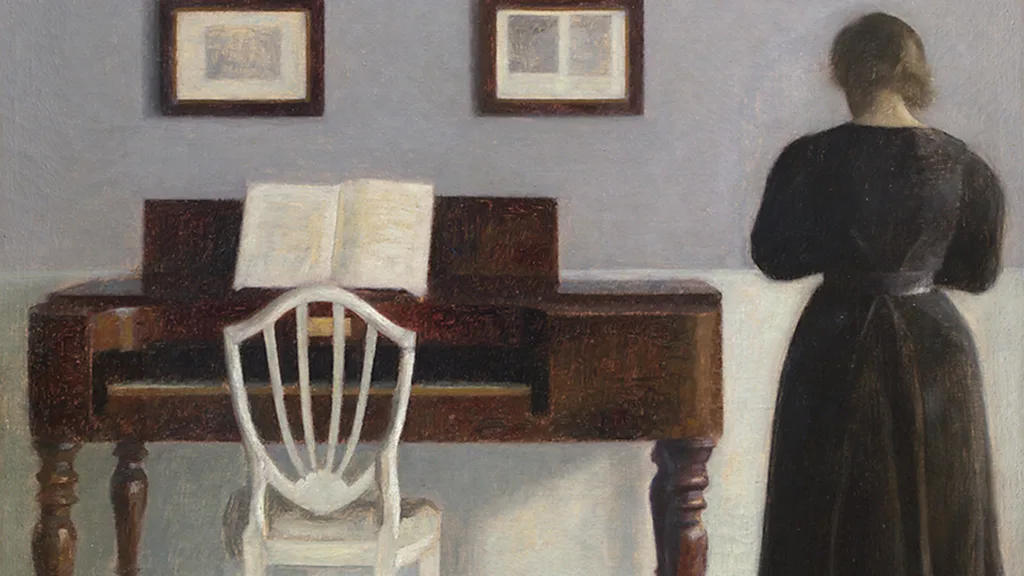Vilhelm Hammershøi’s paintings, quiet and enigmatic, often capture a recurring figure—his wife, Ida, turned away from view, her back facing the audience. In Hammershøi’s 1901 work Interior in Strandgade, Sunlight on the Floor, a woman sits at a table, shrouded in the soft, silvery light filtering through a tall window, her presence enigmatic. Here, Hammershøi creates an atmosphere where light, not the woman, takes on the role of protagonist, diffusing through the room in a silent dance of shadows and brightness. But who was the woman behind these scenes, and what story do these paintings conceal?
Through archival letters, photographs, and observations by contemporaries, the story of Ida Ilsted Hammershøi emerges, revealing a deeply moving but somewhat melancholic life. Hammershøi married Ida in 1891 when he was 27, and she was 22, and she became a vital presence in his work. Seen in over 100 of his paintings, she is a fixture in his minimal, light-filled depictions of their Copenhagen apartment, often with her back turned. This choice denies the viewer a full emotional connection and has led to much speculation about her inner world. Dr. Felix Krämer, a Hammershøi expert and curator of Vilhelm Hammershøi: Silence, notes that the paintings with Ida “give an initial impression that we are seeing into their intimate world,” yet retain an “unknowable” quality that invites varied interpretations.
The Hammershøis’ life together was unusually close-knit. The two traveled together to cities like Paris and Rome but lived quietly in Copenhagen. Jesper Wung Sung, author of Kvinde set fra ryggen (Woman Seen from the Back), a fictionalized account of Ida’s life, notes that Hammershøi and Ida were “a rare and beautiful unity,” inseparable at a time when artists frequently traveled alone. This union, however, meant Ida’s life was tied closely to Vilhelm’s work, and though she supported him, it likely came with sacrifices. Hammershøi’s mother, Frederikke, cast a strong influence on their household, observing their life together with pride yet vigilance. Ida, as her letters reveal, adapted to this constant oversight and strove to support Hammershøi’s singular vision, even amid the challenges posed by his intense devotion to his work and his introspective nature.
Hammershøi’s style, informed by European travels and the influence of artists like Vermeer, diverged from the typical modernist currents of his time, contributing to his prolonged obscurity. His fascination with light and space, heightened by Ida’s subtle presence, resulted in works that resist categorization within mainstream art movements. The distinct Rückenfigur, or back-turned figure, seen in German Romantic painting, notably in Caspar David Friedrich’s Woman at the Window, may have influenced his portrayal of Ida, yet he gave it an emotional ambiguity. While his friend Carl Holsøe portrayed domesticity with warmth, Hammershøi’s interiors remain stark and contemplative, suggesting solitude rather than domestic coziness.
In the final years of Hammershøi’s life, Ida was at his side. She faced numerous trials, from social isolation to her mother’s hereditary “hysteria” and health issues, documented in archival files found by Wung Sung. The discovery that her mother’s grief stemmed from a tragic loss contextualizes Ida’s own sensitivity and, perhaps, her role as the quiet heart of Hammershøi’s world. The painting he made of her in 1907, his last, is a powerful testament to this bond. Wung Sung describes it as “a portrait of a woman who hasn’t lived an easy life, but at the same time, it’s very tender,” embodying Hammershøi’s appreciation and affection for his wife.
Today, as Hammershøi’s legacy continues to grow, the enigma of Ida remains, her silent, contemplative figure immortalized in his paintings. Hammershøi’s nuanced portrayal of Ida, encapsulated in subtle gestures and softened glances, provides glimpses into their shared life—a life marked by quiet resilience and mutual devotion that, much like the artist’s work, transcends time and draws us into its depths.







